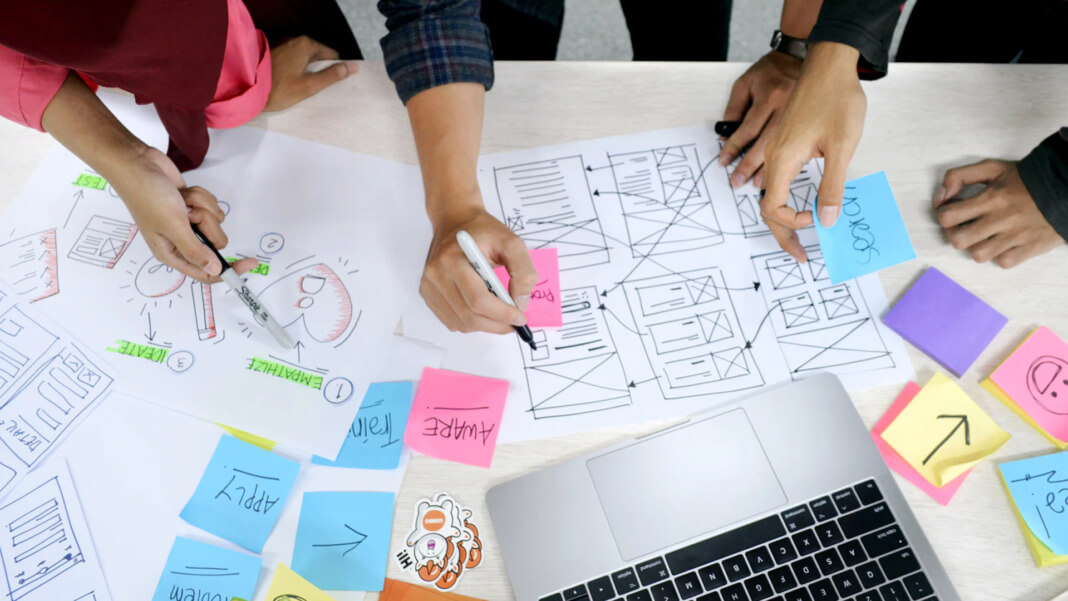You are no stranger to the continual push to innovate if you are a designer, an entrepreneur, or any other type of employee. After all, it’s the secret sauce, the key to development and success. Our ability to innovate — the ability to come up with actionable and compelling ideas — gives us an advantage in competitive sectors.
Tech giants like Apple, Airbnbs, and Ubers are all products of the invention. Now, the challenge for all of these businesses — and, no doubt, yours as well — is to keep innovating to preserve or improve their positions in their particular industries. Innovation cannot be a one-time event; it must be ingrained in the company’s DNA.
This is when design thinking enters the picture.
Design thinking has long been seen as the holy grail of innovation, as well as a cure for stagnation. It has been credited with incredible achievements, such as turning Airbnb from a failed startup to a billion-dollar company. It’s an idea that’s becoming more difficult to dismiss, yet despite such high-profile success stories, it’s still cloaked in mystery.
Enough with the ambiguous terminology and imprecise descriptions. We’ll teach you precisely what design thinking is and how to use it in this post. Let’s get started:
- What is the definition of design thinking?
- What are the design thinking principles?
- What is design thinking, and how can I use it in my project?
- How can I put the design thinking framework into practice?
What is design thinking?
Design thinking began to educate engineers on approaching issues creatively, similar to how designers do. John E. Arnold, a professor of mechanical engineering at Stanford University, was one of the first to write about design thinking. He authored “Creative Engineering” in 1959, which defined the four domains of design thinking.
Design thinking became more popular with the emergence of human-centered design in the 1980s and design firm IDEO in the 1990s. Design thinking had made its way into the corporate sector by the turn of the century. The designer’s toolkit inspired many of the ideas and strategies utilized in design thinking.
So, what is design thinking, exactly?
Design thinking is a philosophy as well as a method for solving complex issues in a user-centered manner. It concentrates on obtaining actual outcomes and solutions that are:
- They are technically feasible: They can be turned into valuable goods or processes.
- Economically viable: The company can afford to put them in place.
- User-friendly: They cater to a genuine human need.
Design thinking is based on the idea that to come up with new solutions; one must think like a designer and approach the problem from the user’s point of view. On the other hand, design thinking is all about getting your hands dirty; the goal is to convert your ideas into natural, tested objects or processes as soon as possible.
Starting with developing empathy for the user and building ideas and prototyping them, the design thinking process describes a set of stages that bring this theory to life.
You probably think that this sounds suspiciously like UX at this point. So, what is it about design thinking that makes it so unique?
We can use design thinking to solve “wicked” problems
The kind of issues that design thinking solves is what distinguishes it. We’re not talking about regular, common problems with tried-and-tested solutions regarding the challenges that can be handled using design thinking. Instead, we’re talking about challenging, “wicked” situations that defy usual methods and approaches to tackle.
Not only are these issues difficult to describe, but any attempt to address them will almost certainly result in the creation of new ones. Wicked problems abound, ranging from global issues like climate change and poverty to obstacles that touch nearly every organization, such as change management, attaining sustainable growth, and preserving your competitive advantage.
Design thinking is a practical method that can be applied to solve the world’s most intractable issues. It promotes user-centricity, creativity, innovation, and thinking beyond the box.
With that in mind, let’s take a closer look at the concepts and pillars of design thinking.
What are the design thinking principles?
Design thinking is based on a set of fundamental concepts. These values are mirrored in the design thinking approach, which we’ll go over in more depth later. Below are five of the essential design thinking principles.
1. Empathy and user-centricity: Finding solutions that respond to human needs and user input is at the heart of design thinking. People, not technology, drive innovation; therefore, putting yourself in the shoes of your target audience and developing genuine empathy for them is an integral part of the process.
2. Collaboration: Design thinking aims to bring together a wide range of viewpoints and ideas, which leads to creativity! In addition, design thinking promotes cooperation across diverse, interdisciplinary teams that may not typically collaborate.
3. Conceptualization / Ideation: Because design thinking is a problem-solving framework, the goal is to generate as many ideas and potential solutions as possible. Thus, ideation is a fundamental design thinking notion and a stage in the design thinking process. The ideation phase is a designated judgment-free zone where participants are encouraged to focus on quantity rather than the quality of ideas.
4. Iteration and experimentation: It’s not only about coming up with ideas; it’s also about prototyping, testing, and making adjustments depending on user input. Because design thinking is an iterative process, expect to repeat certain phases as you find defects and inadequacies in early versions of your suggested solution.
5. Abias towards action: Design thinking is a problem-solving methodology that emphasizes action over debate. Design thinking encourages you to get out there and connect with your people face-to-face rather than speculating about what they want. You’ll convert possible answers into actual prototypes and test them in real-world scenarios rather than talking about them.
Design thinking techniques in action

We’ve gone through a lot of theories thus far. We understand what design thinking is and how it is shaped. Let’s look at how the design thinking approach works in practice, beginning with the five essential phases in the design thinking process.
- Empathize
- Define
- Ideate
- Prototype
- Test
Even though these phases appear to be in order, it’s crucial to note that design thinking isn’t a strictly linear process. Instead, you’re likely to uncover fresh discoveries at each level of the process, requiring you to go back and repeat a prior phase.
Step 1: Empathize
You’ll interact with and watch your target audience throughout the empathize phase. This step’s goal is to create a clear image of your end customers, what difficulties they encounter, and what wants and expectations they have. Then, you’ll conduct surveys, interviews, and observation sessions to develop user empathy.
For instance, suppose you wish to address employee retention by filling out an anonymous survey. After that, you conduct user interviews with as many workers as possible to see how they feel about business retention.
Step 2: Define
The next stage is to develop a concise issue statement based on what you learned during the empathize phase. First, the exact difficulty you will solve is outlined in your problem statement. Second, it will lead you through the rest of the design process, providing you a clear objective to work toward and reminding you to keep the user in mind at all times.
You’ll focus on the end user’s needs rather than the business’s while formulating your issue statement. A good issue statement is human-centered, wide enough to allow for creativity while still detailed enough to give direction and assistance.
Step 3: Ideate
You’ll now try to develop as many ideas and potential solutions as possible, starting with a clear problem definition.
The ideation stage encourages you to think beyond the box and consider fresh possibilities. You’re more likely to liberate your thoughts and stumble across creativity if you focus on numbers rather than the quality of ideas. During dedicated ideation sessions, you’ll utilize various ideation approaches, including bodystorming, reverse thinking, and the worst possible idea.
For example, you have numerous ideation sessions with a range of stakeholders based on what you learned during the empathize phase. You come up with as many suggestions as possible for making your staff happy and therefore more likely to stay with the firm, using your issue description as a guide.
Step 4: Prototype
After you’ve whittled down your ideas to a select few, you’ll create prototypes or “scaled-down” copies of the product or concept you want to test.
The prototype step provides you with something practical to test on actual people. Maintaining a user-centric strategy requires this.
How? Prototypes can range from simple paper models to interactive, digital prototypes, depending on what you’re testing. While developing your prototypes, have a precise aim in mind; know exactly what you want your prototype to depict and try.
Step 5: Test
Your prototypes on actual or representative users in the fifth phase of the design thinking process. You can observe where your prototype performs effectively and where it needs to be improved throughout the testing process. You may make adjustments and enhancements based on customer input before investing time and money in creating and deploying your solution.
You’ll conduct user testing sessions during which you’ll watch your target users engage with your prototype. You can also get feedback verbally. Then, you’ll make modifications to your design or develop a whole new idea based on what you learned throughout the testing process.
Putting the design thinking framework to work on your projects
Design thinking may also start small — you don’t have to be a UX designer to apply it to your work! You may opt to focus on just one component of the design thinking process, such as getting to know your consumers and making a daily effort to be more empathy-driven. If you’re having trouble getting good consumer feedback, for example, you might conduct user interviews to figure out what your customers are lacking.
If you want to emphasize the collaborative element of design thinking, you might conduct brainstorming sessions with members from various teams. If you observe that marketing and design are constantly at odds, for example, a few design thinking-style brainstorming sessions could be just what you need to get everyone on the same page.
Design thinking workshops are another increasingly popular way to apply design thinking. A design thinking workshop will walk you through the entire design thinking process in a short amount of time if you have a specific problem to address, such as coming up with a new product concept or finding out how to increase staff retention. In addition, non-design professionals may learn how to innovate and develop innovative solutions through design thinking seminars, a valuable talent in any industry.





